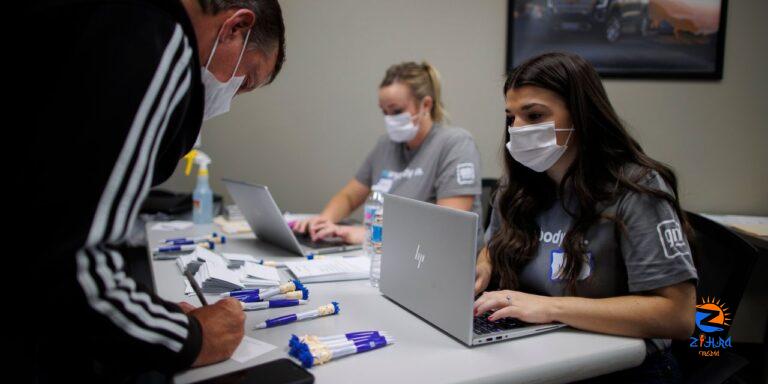
[ad_1]
The cost of hiring new employees and retaining existing ones in the nation’s tight labor market is growing at nearly its fastest pace in a generation. That is helping to fuel inflation as employers pass labor costs to customers.
The U.S. employment-cost index—a quarterly measure of wages and benefits paid by employers—is expected to show that costs continued to rise at the highest rate in two decades of available records. Economists surveyed by The Wall Street Journal expect a seasonally adjusted increase of 1.2% in the fourth quarter of 2021 over the prior three months, which experienced a similar increase. The third-quarter gain, when compared with the same quarter from a year earlier, rose 3.7% on a nonseasonally adjusted basis.
The Labor Department will release the index on Friday at 8:30 a.m. ET.
Economists caution that there are numerous factors contributing to high inflation during the pandemic, especially an overwhelmed supply chain and lopsided demand for physical goods rather than services, leading to mismatches between demand and available goods.
But labor costs are a significant contributor to rising prices. And the current tight labor market is encouraging many workers with bargaining power to switch jobs and demand more pay, raising the risk of a destabilizing inflation dynamic known as a wage-price spiral.
“Inflation has fundamentally picked up and I think it’s fair to say that price gains are feeding back into wage gains as well,” said
Ben Herzon,
executive director at IHS Markit. “There’s a lot of pressure on the supply side on both commodities and labor.”
Investors and Federal Reserve policy makers now consider the labor market to be at or near full employment, despite the fact that the economy has only recovered about 84% of the jobs it had before the pandemic. The labor force has shrunk, and with the unemployment rate now below 4%, the Fed is shifting gears from providing stimulus to the economy to fighting inflation while trying to maintain the labor-market recovery.
After signaling that the Fed would begin steadily raising interest rates in March, Chairman
Jerome Powell
said Wednesday that he believed that price increases have been primarily tied to the “dislocations caused by the pandemic.” But he also said that without more workers returning to the labor market leading to faster growth, higher wages could push prices up.
“We are attentive to the risks that persistent real wage growth in excess of productivity could put upward pressure on inflation,” Mr. Powell said.
The Fed’s preferred measure of inflation, the personal-consumption expenditures price index, rose at 5.7% in November 2021 over the prior year. The December reading will be released on Friday by the Commerce Department. A separate reading of inflation, the consumer-price index, hit 7% in December over the same month a year earlier. Wages rose fast as well, but not enough to keep up with the rise in inflation. Average hourly wages rose 4.7% in December from a year earlier, the Labor Department said.
Wages are rising quickly in disparate parts of the economy, from high-paying finance jobs to lower-paying restaurant and manufacturing positions.
Earlier this month, JPMorgan Chase & Co.’s stock fell on the news that the bank’s expenses would rise 8% in 2022, a figure that includes labor costs and other expenses related to the bank’s investments. “There’s a little bit of labor inflation, and it’s important for us to attract and retain the best talent and pay competitively according to performance,” Chief Financial Officer
Jeremy Barnum
said.
McDonald’s Corp. has raised menu prices to keep pace with rapidly growing costs, with wages up more than 10% at U.S. restaurants. McDonald’s executives have estimated that U.S. menu prices increased about 6% last year on an annual basis, because of increasing costs for labor, food, packaging and other materials. The fast-food company reported a 7.5% increase in U.S. same-store sales for its fourth quarter ended Dec. 31, with the chain attributing the growth to menu price increases and promotions.
“It appears that labor costs are actually accelerating at a much faster pace, and firms have already demonstrated that, in the aggregate, they have significant pricing power to pass those rising costs along to their customers,” said
Stephen Stanley,
chief economist at Amherst Pierpoint.
Employment costs are rising at uneven rates in different industries, depending on the demand for labor. During the summer, airplane manufacturers and their suppliers saw labor costs jump by 7% in a quarter during a hiring binge to replace the workers let go when air travel nosedived early in the pandemic.
At Tool Gauge, a Tacoma, Wa.-based parts manufacturer primarily for
Boeing Co.
aircraft, the head count dropped from around 220 employees before the pandemic to 84 at the low point. Now, with 95 employees, the company is trying to increase staff to address a backlog of work.
“If we had a magic wand, we’d immediately onboard at least another 15 workers,” said Jim Lee, Tool Gauge’s general manager.
They have turned to previously retired workers and started to allow part-time work, just to get more hands on deck. Mr. Lee said he recruited one retiree during a chat at a marina. The former employee decided to come in three days a week so he would have more money to spend on his boat, a retirement passion.
The company has raised wages for entry-level employees from $15 to between $16 and $18. That required them to adjust salaries for nearly everyone else too, other than a few managers. Combined, the company has had a half-million dollar increase in payroll costs. They are currently in negotiations with customers about factoring in those cost increases into future contracts.
“My concern is that we don’t know when this hyperinflation for labor costs will end,” Mr. Lee said.
—Harriet Torry contributed to this article.
Write to Gabriel T. Rubin at gabriel.rubin@wsj.com
Copyright ©2022 Dow Jones & Company, Inc. All Rights Reserved. 87990cbe856818d5eddac44c7b1cdeb8
[ad_2]
